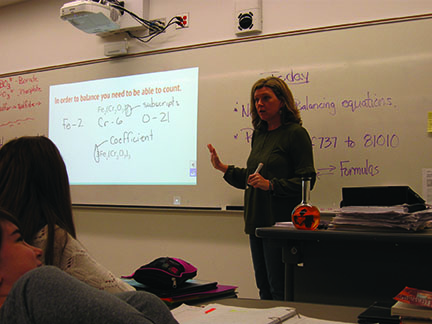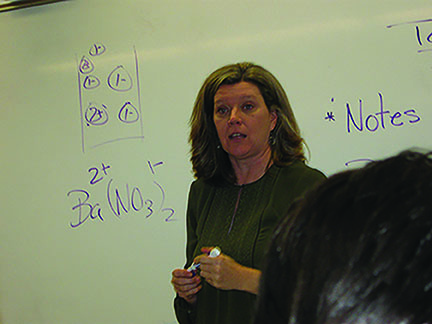
After missed weeks of school due to recovery time from brain surgery, chemistry teacher Shelly Holmberg is now back teaching in her classroom. “I am super happy to be back. People underestimate that just a normal life is a blessing,” Holmberg says.
Holmberg returns after brain tumor removed
“People underestimate that a normal life is a blessing,” chemistry teacher Shelly Holmberg said.
Normal lives can easily be taken for granted. However, Holmberg learned the value of normalcy when she began showing symptoms for a brain tumor. Her diagnosis, recovery from surgery, and missing the first few weeks of school, taught Holmberg that the value of having a normal life is tremendous.
Holmberg had to deal with symptoms such as double vision and headaches for 6 months before she was diagnosed. For those very long 6 months, her doctors could not figure out what could be causing her symptoms, and no painkillers helped much, if at all. She was finally diagnosed during Memorial Day weekend, 2016 with a benign brain tumor.
Diagnosis
Holmberg’s symptoms were all directly connected to her tumor, which means that there was no treatment for any of her symptoms individually. Since Holmberg was not showing most of the symptoms of a brain tumor at first, doctors could not seem to figure out what was causing her pain.
“People were having a hard time diagnosing my symptoms and there was no cure for them individually. But because it was a brain tumor that was putting pressure on my nerves, then they could take care if it all at once so I could get back to normal,” Holmberg said.
Everyone has different reactions to finding out they have something wrong with their health, especially when it is something as big as a brain tumor. Most people are scared or nervous when they hear that diagnosis. However, this was not the case for Holmberg.
“When I found out I had a tumor, I was actually very happy, which sounds weird,” Holmberg said. “There was not a way to get rid of the symptoms I was having, but because they were caused by a brain tumor, when you get rid of my tumor then you get rid of my symptoms.”
Recovery from surgery
There are many drawbacks after recovering from surgery. Particularly in brain surgery, many people also have to deal with effects of surgery for awhile before they can fully regain their health.
“When I was recovering from the surgery, I wasn’t supposed to lift things, I wasn’t supposed to drive, and I had double vision, which is funky. It was like everything one side of my world was double and the other side was not. I could get rid of it if I turned my head sideways, so I walked around with my head sideways a lot. Or I could lay down and it would go away,” Holmberg explained. “Although after the surgery, some of the symptoms went away instantly. A part of my deal was that a nerve was pinched on the left side of my face and that was instantly fixed. But I still feel like somebody cracked me in the head with a baseball bat. I’m still waiting for that to go away.”
Holmberg, in particular, had a tough time transitioning from being a hands-on mom and teacher to having to stay on the sidelines.
“I just had to play it low key after surgery and I’m not a good low-key kind of person. I like to be in there doing things and I just couldn’t. That was really hard for me. I watched my kids walk out the door and I’m used to going with them and all of a sudden I kind of didn’t want to because I just didn’t have the energy to,” Holmberg said. “Lots of times I would suck it up and go anyway and I’m glad I did but it was hard.”
Back to school
Due to her surgery, Holmberg could not be there at the start of school to teach her chemistry classes. Most teachers teach because it is what they love to do. For Holmberg, not being able to be there at the start of a new school year was very difficult.
“Missing the first few weeks of school was awful. It was hard not being able to have a normal life. I love normal and I love my job,” Holmberg said.
Holmberg not being able to teach for the first part of the school year was hard on her students as well. Although now that Holmberg is back in her element, her students enjoy her class and as their teacher.
“Considering we do have a great science program, Mrs. Holmberg is definitely one of the better science teachers. She really embraces chemistry,” junior Sydney Johnson said.
School days are 6 and a half hours long which is a very long time to be working while still recovering from surgery. Not to mention having to be around students who are sometimes headaches for teachers who did not just have brain surgery. However, for Holmberg, school seemed to have the opposite effect.
“It feels good to be back in school teaching and it actually helped my energy. I thought it would drain my energy and sure, by the end of the day, it does. But for the most part, it helps,” Holmberg explained.
Students in her last hour don’t even notice her energy levels down. If Holmberg hadn’t told them she was gone due to her brain tumor, students wouldn’t have ever known.
“If I had no idea what happened to her, I would never have guessed she was out due to a brain tumor. But since I do know, I can say that she’s doing really great,” Johnson explained.
Getting back to a normal life will still take some time for Holmberg but she is well on her way there. Even just being back in her normal routine has had a positive impact.
“Being around students helps me forget about the little issues I have that are lingering. And I need to forget about them,” Holmberg explained. “I just want to put it all behind me and move forward.”
